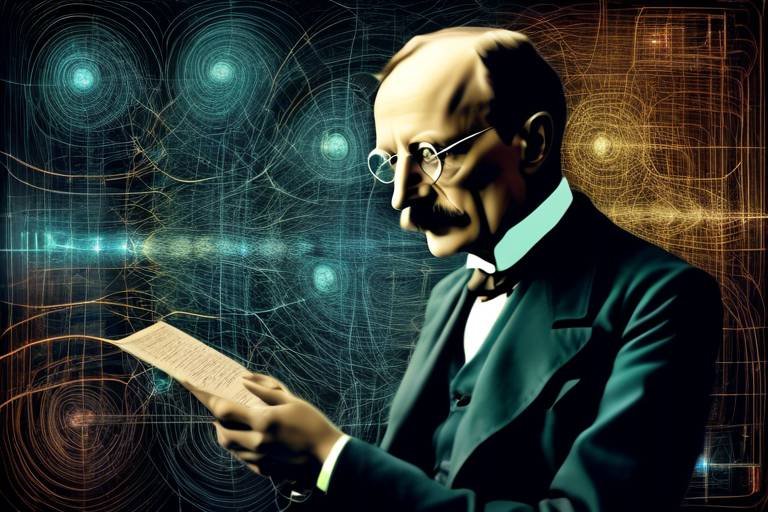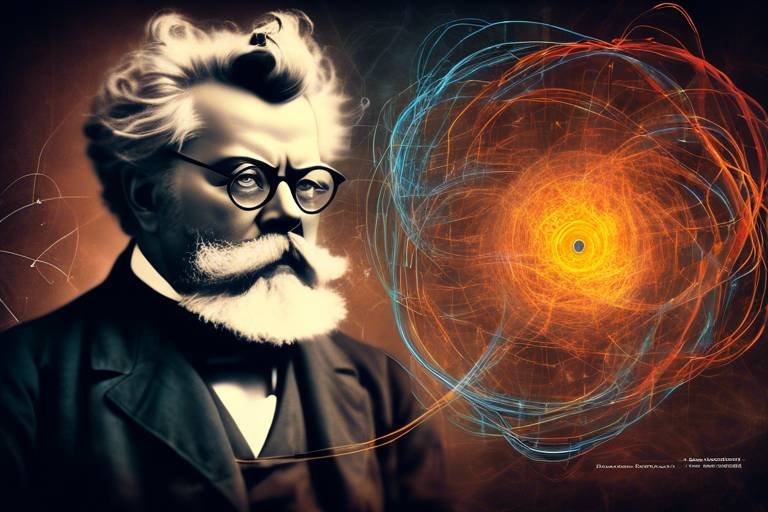Henrietta Lacks and the Immortal HeLa Cells
In the annals of medical history, few stories resonate as profoundly as that of Henrietta Lacks. Born in 1920 in Roanoke, Virginia, Henrietta's life was tragically cut short by cervical cancer, yet her legacy endures through the immortal cells that were taken from her without consent. These cells, known as HeLa cells, have revolutionized medical research and paved the way for countless breakthroughs. But beyond the scientific marvel lies a complex narrative filled with ethical dilemmas and questions about consent, race, and the intersection of science and humanity.
Henrietta's journey began in a time when medical ethics were often overlooked, particularly for African American patients. Her cells were harvested in 1951 during a routine treatment at Johns Hopkins Hospital, setting off a chain reaction that would lead to advancements in various fields of science. The story of HeLa cells is not just one of scientific triumph; it is also a cautionary tale about the importance of ethical standards in research. As we delve deeper into her life and the implications of her cells, we uncover a narrative that challenges us to think critically about the ethics of medical research and the rights of patients.
The discovery of HeLa cells marked a turning point in biomedical research. Unlike any other cells studied before, HeLa cells exhibit the remarkable ability to divide indefinitely in laboratory settings. This characteristic has made them a cornerstone for research in cancer, genetics, and virology. Imagine a cell that just won't quit, that keeps multiplying and thriving, making it an ideal candidate for experiments that can lead to significant medical advancements. This unique property of HeLa cells has allowed scientists to conduct experiments that were once thought impossible, pushing the boundaries of what we know about human biology.
However, the story of Henrietta Lacks and her cells is not just about science; it's a powerful reminder of the ethical considerations that must accompany medical research. The collection of her cells without informed consent raises profound questions about the exploitation of vulnerable populations. Henrietta's experience is a reflection of a broader issue in medical history, where the contributions of African Americans and other marginalized groups have often been overlooked or taken for granted. As we explore the implications of her story, we must grapple with the lessons it teaches us about consent, respect, and the need for equitable practices in healthcare.
As we move forward in this exploration of HeLa cells, we will uncover their immense impact on medical research, the groundbreaking discoveries they have facilitated, and the legacy of Henrietta Lacks herself. Her story is a testament to resilience and a call to action for ethical reform in the medical community. Join us as we dive deeper into the world of HeLa cells, their applications in research, and the enduring legacy of a woman who changed the face of science forever.
- What are HeLa cells? HeLa cells are the first immortal human cell line, derived from Henrietta Lacks's cervical cancer cells in 1951. They can divide indefinitely in laboratory conditions, making them invaluable for research.
- Why are HeLa cells important in medical research? HeLa cells have contributed to numerous medical breakthroughs, including the development of vaccines, cancer treatments, and advancements in genetic research.
- What ethical issues surround the use of HeLa cells? The cells were taken without Henrietta Lacks's consent, raising significant ethical questions about patient rights, informed consent, and the exploitation of marginalized communities in medical research.
- How has Henrietta Lacks's legacy influenced modern medicine? Her story has sparked discussions on the importance of ethical practices in research, leading to changes in policies regarding informed consent and the treatment of patients in medical settings.

The Life of Henrietta Lacks
Henrietta Lacks was born on August 1, 1920, in Roanoke, Virginia, into a family of tobacco farmers. Growing up in the segregated South, her early life was marked by hardship and the challenges of racial discrimination. Henrietta, the great-granddaughter of a slave, faced not only the struggles of poverty but also the societal limitations imposed on African Americans during that era. Despite these challenges, she was known for her vibrant spirit and her desire to provide for her family.
In 1941, at the age of 21, Henrietta married David Lacks and together they had five children. Their life was not easy, as they often struggled to make ends meet. Henrietta worked various jobs, including as a domestic worker, to support her family. However, her life took a tragic turn when she was diagnosed with cervical cancer in 1951. The diagnosis came after she noticed a painful lump in her abdomen, which she initially dismissed as a sign of pregnancy. When she finally sought medical help at Johns Hopkins Hospital, the doctors discovered that her cancer had progressed significantly.
During her treatment, which included radiation therapy, doctors took a sample of her tumor cells without her knowledge or consent. This was a common practice at the time, particularly among African American patients who often received inadequate information about their medical treatment. The cells taken from Henrietta's tumor would later become known as HeLa cells, marking the beginning of a new era in medical research.
Henrietta's battle with cancer was fierce, but unfortunately, she succumbed to the disease on October 4, 1951, at the young age of 31. Little did she know that her cells would continue to live on and contribute to groundbreaking scientific advancements long after her death. Her story is not just one of personal struggle but also a reflection of the broader issues of race, ethics, and medical consent that continue to resonate today.
Henrietta Lacks's legacy is a powerful reminder of the human stories behind scientific progress. It raises important questions about the ethical implications of medical research and the treatment of patients, especially those from marginalized communities. Her life and the story of HeLa cells have become a significant part of discussions surrounding medical ethics, patient rights, and the need for informed consent in research.

The Discovery of HeLa Cells
The story of HeLa cells begins in the early 1950s at Johns Hopkins Hospital, where a young African American woman named Henrietta Lacks was undergoing treatment for cervical cancer. During her treatment, doctors took a sample of her tumor without her knowledge or consent. Little did they know that this sample would lead to one of the most important discoveries in medical research history. The cells taken from Henrietta's tumor were unlike any other cells that had been studied before; they had the remarkable ability to survive and replicate indefinitely in laboratory conditions. This unique property was a game-changer for scientists, who had been struggling to cultivate human cells for research purposes.
Initially, researchers were baffled by the resilience of these cells. Named HeLa cells after Henrietta Lacks, they quickly became a cornerstone for various fields of medical research. Unlike normal human cells, which typically have a limited lifespan and die after a certain number of divisions, HeLa cells can divide endlessly. This immortality is due to a unique mechanism involving the enzyme telomerase, which maintains the ends of chromosomes, allowing the cells to replicate beyond the normal limits. In essence, HeLa cells became a biological fountain of youth for researchers, providing a consistent and renewable resource for experiments.
The discovery of HeLa cells opened the door to numerous scientific advancements. They were instrumental in developing the polio vaccine, studying cancer, and understanding the effects of radiation and toxic substances on human cells. Researchers could conduct experiments that were previously impossible, leading to breakthroughs in our understanding of human biology. For instance, HeLa cells were used to study the behavior of cancer cells, leading to better treatment options for patients suffering from similar diseases.
Furthermore, the rapid proliferation of HeLa cells in culture enabled scientists to conduct large-scale experiments, which was crucial for the progress of medical research. One notable example is the development of the polio vaccine by Dr. Jonas Salk. He used HeLa cells to test the vaccine's efficacy, ultimately leading to the near eradication of polio in many parts of the world. The impact of HeLa cells on public health cannot be overstated, as they have played a vital role in saving countless lives.
To summarize the significance of HeLa cells, here’s a brief overview:
| Significance of HeLa Cells | Impact |
|---|---|
| Vaccine Development | Crucial for polio vaccine testing |
| Cancer Research | Helped in understanding cancer cell behavior |
| Genetics Studies | Advancements in genetic research and therapies |
| Virology | Understanding viral infections and treatments |
Despite their monumental contributions to science, the journey of HeLa cells also raises serious ethical questions regarding consent and the treatment of African American patients in medical research. Henrietta Lacks's story is a poignant reminder of the human lives behind scientific progress. As we explore the incredible impact of HeLa cells, it’s essential to acknowledge the ethical considerations that accompany such groundbreaking discoveries.

Characteristics of HeLa Cells
HeLa cells are not your average cells; they are a remarkable phenomenon in the world of biology. Derived from the cervical cancer cells of Henrietta Lacks in 1951, these cells have become a cornerstone of medical research. What makes HeLa cells so special? For starters, they possess an extraordinary ability to divide indefinitely. Unlike normal human cells that have a limited lifespan, HeLa cells can replicate endlessly in a laboratory setting. This unique trait has made them invaluable for scientists around the globe.
One of the key characteristics of HeLa cells is their resilience and adaptability. They thrive in various conditions, allowing researchers to conduct experiments under a wide range of environments. This adaptability is crucial, as it enables scientists to test hypotheses and develop treatments that might otherwise be impossible. In fact, HeLa cells have been sent to laboratories all over the world, demonstrating their versatility and importance in scientific inquiry.
Another fascinating aspect of HeLa cells is their genetic stability. While many cell lines can suffer from mutations over time, HeLa cells have maintained a relatively stable genome. This stability allows researchers to produce consistent results in experiments, making them a reliable choice for long-term studies. Moreover, HeLa cells have been instrumental in understanding the complexities of human genetics and cellular behavior.
To summarize, here are some of the standout characteristics of HeLa cells:
- Indefinite Division: HeLa cells can replicate indefinitely, making them a crucial tool for research.
- Resilience: They can survive in various laboratory conditions, allowing for diverse experimental setups.
- Genetic Stability: HeLa cells maintain a stable genome, providing consistent experimental results.
These characteristics have enabled HeLa cells to play a pivotal role in numerous scientific breakthroughs. From cancer research to vaccine development, the contributions of HeLa cells are immeasurable. Their unique properties not only highlight the potential of cellular biology but also raise important questions about ethics and the treatment of human tissues in research.

Immortality of HeLa Cells
The concept of immortality in biological terms might sound like something straight out of a sci-fi movie, but when it comes to HeLa cells, it's a fascinating reality. These cells, derived from Henrietta Lacks, possess the remarkable ability to divide and replicate indefinitely in a laboratory setting. This unique characteristic is not just a trivial detail; it has profound implications for scientific research and medical advancements. How is it that these cells can defy the natural aging process that affects most living organisms? The answer lies in their extraordinary biological mechanisms.
To understand the immortality of HeLa cells, we need to delve into the genetics and cellular biology that set them apart. HeLa cells are known to have an abnormal number of chromosomes, which contributes to their ability to replicate without the usual restrictions that limit cell division. In most human cells, a process called senescence occurs after a certain number of divisions, effectively putting a cap on their lifespan. However, HeLa cells bypass this limitation, allowing them to continue dividing endlessly. This phenomenon is largely attributed to the presence of the enzyme telomerase, which maintains the length of telomeres—the protective caps at the ends of chromosomes that shorten with each division.
But the story doesn't end there. The immortality of HeLa cells has paved the way for countless breakthroughs in various fields of research. For instance, these cells have been instrumental in cancer research, enabling scientists to study the disease's progression and test new treatments in a controlled environment. They have also played a crucial role in understanding viral infections and the development of vaccines.
Here are some key points regarding the immortality of HeLa cells:
- Continuous Division: HeLa cells can divide every 20 to 24 hours, providing a constant supply of cells for experimentation.
- Research Versatility: Their unique properties make them suitable for a wide range of studies, from genetics to toxicology.
- Ethical Implications: The ability to replicate indefinitely raises questions about the ethics of using human cells in research without consent.
In summary, the immortality of HeLa cells is not merely a scientific curiosity; it represents a pivotal moment in biomedical research. By unlocking the secrets of these cells, scientists have gained invaluable insights into human health, disease mechanisms, and potential treatments. Yet, this scientific marvel also serves as a reminder of the ethical responsibilities that come with such powerful tools. The legacy of Henrietta Lacks and her immortal cells continues to influence the way we think about consent, ownership, and the humanity behind scientific progress.
1. What are HeLa cells?
HeLa cells are a line of immortal cells derived from the cervical cancer cells of Henrietta Lacks, which have been used extensively in medical research.
2. Why are HeLa cells considered immortal?
HeLa cells are considered immortal because they can divide indefinitely in laboratory conditions, largely due to the presence of the enzyme telomerase, which prevents the normal aging process of cells.
3. How have HeLa cells contributed to medical research?
HeLa cells have been crucial in various medical breakthroughs, including the development of vaccines, cancer treatments, and understanding human biology.
4. What ethical issues are associated with HeLa cells?
The use of HeLa cells raised significant ethical questions regarding consent, as Henrietta Lacks's cells were collected without her knowledge or permission, highlighting issues of exploitation in medical research.

Applications in Research
HeLa cells have proven to be a game changer in the realm of scientific research, serving as a vital tool in various fields. Their unique properties, such as the ability to divide indefinitely, have enabled researchers to conduct experiments that were previously impossible. From cancer research to vaccine development, HeLa cells have been at the forefront of numerous groundbreaking studies. Imagine having a reliable source of cells that can replicate endlessly, allowing scientists to test hypotheses and develop treatments without the constraints of time. This has led to significant advancements, particularly in understanding complex biological processes.
One of the most notable applications of HeLa cells is in the field of cancer research. Researchers have used these cells to study the mechanisms of cancer cell growth and to test new cancer therapies. For instance, the development of chemotherapy drugs has heavily relied on HeLa cells to evaluate their effectiveness and safety before moving into clinical trials. Without these cells, the path to effective cancer treatments would have been much more challenging.
Moreover, HeLa cells have played a crucial role in genetic research. They were instrumental in the discovery of the role of telomerase in cellular aging and the understanding of genetic mutations that lead to cancer. This research has paved the way for potential gene therapies that could one day correct genetic defects in patients. The ability to manipulate HeLa cells genetically has opened up new avenues for studying gene function and regulation, providing insights that are essential for advancing personalized medicine.
In the realm of virology, HeLa cells have been indispensable. They were central to the development of the polio vaccine, allowing researchers to grow the poliovirus in large quantities for vaccine production. This not only highlights the importance of HeLa cells in vaccine development but also underscores their role in public health. By enabling the mass production of vaccines, HeLa cells have contributed to the eradication of diseases that once plagued humanity.
To illustrate the broad applications of HeLa cells in research, consider the following table that summarizes key areas where these cells have made a significant impact:
| Research Field | Key Contributions |
|---|---|
| Cancer Research | Development of chemotherapy drugs and understanding cancer cell mechanisms. |
| Genetics | Insights into gene function, telomerase research, and potential gene therapies. |
| Virology | Development of the polio vaccine and studies on viral infections. |
| Pharmacology | Testing drug efficacy and safety before clinical trials. |
In summary, the applications of HeLa cells in research are vast and varied, making them a cornerstone of modern biomedical science. Their contribution to understanding diseases, developing treatments, and advancing medical knowledge cannot be overstated. As we continue to explore the potential of these immortal cells, we can only imagine the future breakthroughs that await us, thanks to the legacy of Henrietta Lacks.
- What are HeLa cells? HeLa cells are a line of immortal cells derived from Henrietta Lacks' cervical cancer cells, which have been used extensively in scientific research.
- Why are HeLa cells important? HeLa cells have unique properties that allow them to replicate indefinitely, making them invaluable for research in various fields, including cancer, genetics, and virology.
- What ethical issues are associated with HeLa cells? The collection and use of Henrietta Lacks' cells without her consent raise significant ethical questions regarding patient rights and informed consent in medical research.
- How have HeLa cells contributed to vaccine development? HeLa cells were crucial in the development of the polio vaccine, allowing researchers to grow the virus needed for vaccine production.

Ethical Considerations
The story of Henrietta Lacks is not just a tale of scientific discovery; it is also a profound reflection on the ethical landscape of medical research. When Henrietta's cells were taken without her knowledge or consent, it raised significant questions about the rights of patients and the responsibilities of researchers. Imagine being a patient, trusting the medical system to care for you, only to have your biological material used for profit and research without your say. This is the reality that Henrietta faced, and it has left a lasting impact on how we view consent in medical practices today.
One of the most pressing ethical issues is the concept of informed consent. In Henrietta's time, the idea that patients should be fully informed about the use of their tissues was not a standard practice. The lack of consent not only violated her personal rights but also set a precedent for the exploitation of marginalized groups, particularly African Americans, in medical research. This exploitation is a stark reminder of the historical injustices within the healthcare system, where individuals from minority backgrounds have often been treated as mere subjects rather than as human beings with rights.
Furthermore, the story of HeLa cells brings to light the broader implications of race and ethics in medicine. The African American community has a long history of mistrust towards medical institutions, stemming from unethical practices like the Tuskegee Syphilis Study. Henrietta's case adds another layer to this distrust, emphasizing the need for transparency and respect in medical research. Researchers today are increasingly aware that ethical considerations must go hand-in-hand with scientific inquiry.
In response to these ethical dilemmas, many institutions have developed guidelines and regulations to ensure that patients are informed and that their rights are protected. For instance, the establishment of Institutional Review Boards (IRBs) has become a crucial step in overseeing research studies to ensure ethical compliance. These boards evaluate research proposals to safeguard participants' rights, ensuring that informed consent is obtained and that the risks are minimized.
Moreover, the conversation surrounding Henrietta Lacks has sparked a movement towards greater awareness and advocacy for patient rights. Organizations and researchers are now more committed to engaging with communities and ensuring that their voices are heard in the research process. This shift is essential for building trust and fostering a collaborative environment where patients feel valued and respected.
In conclusion, the ethical considerations surrounding Henrietta Lacks's story are multifaceted and deeply significant. They challenge us to rethink our approach to medical research and patient rights. As we move forward, it is crucial to remember Henrietta not just as a source of scientific advancement but as a symbol of the ongoing struggle for ethical integrity in medicine. Her legacy serves as a reminder that behind every scientific breakthrough, there is a human story that deserves to be honored and respected.
- What were HeLa cells used for? HeLa cells have been instrumental in various research fields, including cancer research, vaccine development, and genetic studies.
- Why is informed consent important? Informed consent ensures that patients are aware of how their biological materials will be used and that they have the right to make decisions about their own bodies.
- How has Henrietta Lacks's story influenced modern medical ethics? Her story has led to increased awareness of ethical practices in research, particularly regarding the treatment of marginalized groups.

Impact on Medical Research
The impact of HeLa cells on medical research is nothing short of revolutionary. These remarkable cells have paved the way for countless breakthroughs in various fields of medicine, fundamentally altering our understanding of human biology. Imagine a world where scientists could study human cells that never die, allowing them to conduct experiments that were previously unimaginable. That's precisely what HeLa cells have offered since their discovery. They have been instrumental in developing treatments for diseases, understanding genetic disorders, and even in the fight against viruses.
One of the most significant contributions of HeLa cells has been in the realm of vaccine development. For instance, during the 1950s, researchers utilized HeLa cells to create the polio vaccine, a groundbreaking achievement that has saved millions of lives worldwide. The ability to grow these cells indefinitely meant that scientists could produce large quantities of them for experimentation, leading to faster and more efficient research processes. This efficiency is critical, especially during health crises when time is of the essence.
Furthermore, HeLa cells have played a vital role in cancer research. By studying these cells, scientists have gained insights into how cancer develops and progresses. They have been used to test the efficacy of new chemotherapy drugs, leading to improved treatment options for patients. The ability of HeLa cells to replicate indefinitely allows researchers to observe the long-term effects of various treatments, providing invaluable data that would be impossible to obtain otherwise.
In addition to their contributions to vaccine and cancer research, HeLa cells have been pivotal in understanding human genetics. They have been used to explore the intricacies of DNA, gene expression, and hereditary diseases. The knowledge gained from studying these cells has not only advanced our understanding of genetics but has also opened doors to gene therapy, which holds promise for treating genetic disorders at their source.
To illustrate the wide-ranging impact of HeLa cells, let's take a look at some key areas where they have made a difference:
| Research Area | Key Contributions |
|---|---|
| Vaccine Development | Polio vaccine research, measles vaccine testing |
| Cancer Research | Testing chemotherapy drugs, understanding tumor biology |
| Genetics | Gene mapping, studies on genetic disorders |
| Virology | Research on HIV, herpes, and other viruses |
It's essential to recognize that while the contributions of HeLa cells to medical research are immense, they also raise important questions about ethics and consent. The story of Henrietta Lacks reminds us that behind every scientific advancement, there are real people whose lives and bodies are involved. As we continue to benefit from the discoveries made possible by HeLa cells, we must also strive to ensure that ethical standards are upheld in medical research, honoring the legacy of Henrietta and countless others.
- What are HeLa cells? HeLa cells are a line of human cells derived from cervical cancer cells taken from Henrietta Lacks in 1951. They are known for their ability to divide indefinitely in laboratory conditions.
- Why are HeLa cells important in research? HeLa cells have contributed to numerous medical breakthroughs, including the development of vaccines, cancer treatments, and advancements in genetics.
- What ethical concerns are associated with HeLa cells? The collection of Henrietta Lacks's cells was done without her consent, raising significant ethical questions about patient rights and informed consent in medical research.
- How have HeLa cells influenced modern medicine? HeLa cells have played a crucial role in understanding diseases, testing treatments, and developing vaccines, significantly impacting public health and medical practices.

HeLa Cells and Vaccine Development
When we think about vaccines, we often picture scientists in lab coats, pipettes in hand, working diligently to save lives. But behind many of these groundbreaking medical advancements lies a fascinating story intertwined with the legacy of Henrietta Lacks and her immortal HeLa cells. These remarkable cells have played a pivotal role in the development of various vaccines, most notably the polio vaccine. Imagine a world where polio was still rampant, where children were paralyzed by a disease that could have been prevented. Thanks to HeLa cells, we are spared that grim reality.
HeLa cells were the first human cells successfully cloned and have the unique ability to divide indefinitely. This characteristic makes them an invaluable resource for researchers. They provide a consistent and reliable means to test vaccines and study viral infections. For instance, during the 1950s, scientists needed a way to grow the poliovirus in the lab to develop a vaccine. Traditional methods using animal cells were not yielding the desired results. Enter HeLa cells, which allowed researchers to grow the virus in abundance, paving the way for the successful development of the polio vaccine by Dr. Jonas Salk.
But the contribution of HeLa cells doesn’t stop there. They have been utilized in the development of vaccines for diseases such as influenza and measles, among others. The ability to produce large quantities of viruses in a controlled environment has led to safer and more effective vaccines. This is crucial not only for the development of new vaccines but also for ensuring that existing vaccines remain effective against evolving strains of viruses.
Here’s a quick look at some of the vaccines that have benefited from HeLa cell research:
| Vaccine | Diseases Prevented | Year Developed |
|---|---|---|
| Polio Vaccine | Polio | 1955 |
| Measles Vaccine | Measles | 1963 |
| Influenza Vaccine | Influenza | 1945 |
In addition to vaccine development, HeLa cells have also been instrumental in understanding how viruses interact with human cells. This knowledge is crucial for developing new vaccines and treatments, especially in an era where emerging viruses pose a significant threat to global health. The ability to study these interactions in a laboratory setting has opened doors to innovations that were once thought impossible.
However, it’s essential to recognize that the journey of HeLa cells from Henrietta Lacks to vaccine development raises significant ethical questions. While her cells have contributed immensely to medical science, the lack of consent and recognition of her contributions has sparked discussions about patient rights and the ethics of using human biological materials in research. Henrietta’s story serves as a reminder that behind every scientific breakthrough, there are real people whose lives and legacies are intertwined with the research.
As we celebrate the advancements made possible by HeLa cells, we must also advocate for ethical practices in medical research. Ensuring that the contributions of individuals like Henrietta Lacks are acknowledged and respected is vital for the future of biomedical ethics.

Legacy of Henrietta Lacks
The legacy of Henrietta Lacks is profound and multifaceted, extending far beyond her remarkable contribution to science. Her story has become a powerful symbol of the intersection between ethics and medical research, particularly regarding consent and the treatment of African American patients. Henrietta's cells, known as HeLa cells, have played a pivotal role in numerous scientific advancements, but her life and the circumstances surrounding the use of her cells raise critical questions about the rights of individuals in medical research.
One of the most significant aspects of Henrietta's legacy is the ongoing dialogue it has sparked about informed consent. For decades, her cells were used without her knowledge or permission, highlighting a troubling trend in medical history where marginalized communities were often exploited. This has led to a greater emphasis on the need for ethical guidelines and regulations in research practices. Today, researchers are more aware of the importance of obtaining consent, ensuring that patients are informed about how their biological materials will be used.
Moreover, Henrietta's story has ignited discussions about racial disparities in healthcare. It serves as a reminder of the historical injustices faced by African Americans in the medical field. The conversation around her legacy encourages not only awareness but also action towards equity in healthcare access and treatment. This has inspired many organizations and researchers to advocate for better representation and ethical treatment of all patients, particularly those from underrepresented backgrounds.
In a broader context, Henrietta Lacks's legacy has influenced the field of biomedical ethics. Her story was popularized by Rebecca Skloot's bestselling book, "The Immortal Life of Henrietta Lacks," which brought her life and contributions to the forefront of public consciousness. The book has been instrumental in educating the public about ethical issues in medical research, inspiring a new generation of scientists and ethicists to prioritize patient rights and ethical considerations in their work.
In summary, the legacy of Henrietta Lacks is not just about the scientific advancements made possible by HeLa cells; it is also about the ethical implications of her story. Her life has become a catalyst for change, prompting a reevaluation of how patients are treated in the world of medical research. As we continue to benefit from the contributions of HeLa cells, it is essential to remember Henrietta's story and advocate for a more ethical and equitable future in healthcare.
- What are HeLa cells? HeLa cells are the first immortal human cell line, derived from Henrietta Lacks's cervical cancer cells in 1951. They can divide indefinitely in laboratory settings, making them invaluable for research.
- Why is Henrietta Lacks's story important? Her story highlights ethical issues in medical research, particularly concerning informed consent and the exploitation of African American patients.
- How have HeLa cells contributed to science? HeLa cells have been instrumental in various medical breakthroughs, including the development of the polio vaccine, cancer research, and advancements in genetics and virology.
- What impact did Henrietta's legacy have on modern ethics? Henrietta's legacy has led to increased awareness of patient rights and the importance of ethical practices in medical research, influencing policies and regulations to protect individuals.
Frequently Asked Questions
- Who was Henrietta Lacks?
Henrietta Lacks was an African American woman whose cells were taken without her knowledge in 1951 while she was being treated for cervical cancer. Her cells became known as HeLa cells, which have been used extensively in medical research.
- What are HeLa cells?
HeLa cells are the first immortal human cell line, meaning they can divide indefinitely in a laboratory setting. They are derived from Henrietta Lacks's cervical cancer cells and have played a crucial role in numerous scientific breakthroughs.
- Why are HeLa cells important in research?
HeLa cells are important because they have unique properties that allow them to survive and replicate outside the human body. This has made them invaluable for research in areas such as cancer, genetics, and virology, leading to significant medical advancements.
- What ethical issues arose from the use of HeLa cells?
The collection and use of Henrietta Lacks's cells raised serious ethical concerns, particularly regarding informed consent. Her cells were taken without her permission, highlighting issues of exploitation and the need for ethical standards in medical research.
- How did HeLa cells contribute to vaccine development?
HeLa cells were instrumental in the development of the polio vaccine. Researchers used these cells to test and grow the virus, which ultimately led to the creation of a vaccine that has saved countless lives worldwide.
- What is Henrietta Lacks's legacy?
Henrietta Lacks's legacy is profound, sparking discussions about ethics in medicine, patient rights, and informed consent. Her story has led to greater awareness and changes in how medical research is conducted, especially regarding minority patients.
- Are HeLa cells still used in research today?
Yes, HeLa cells are still widely used in research today. Their unique properties continue to aid scientists in understanding various diseases and developing new treatments, making them a cornerstone of modern biomedical research.



















